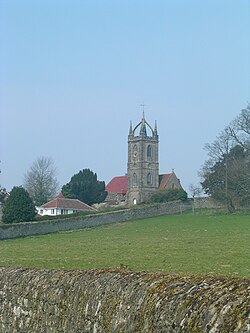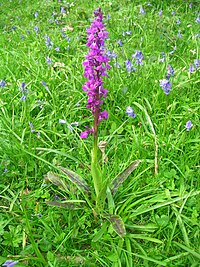Tillington, Sussex
| Tillington | |
| Sussex | |
|---|---|
 All Hallows | |
| Location | |
| Grid reference: | SU962219 |
| Location: | 50°59’21"N, -0°37’47"W |
| Data | |
| Population: | 524 (2011) |
| Post town: | Petworth |
| Postcode: | GU28 |
| Dialling code: | 01798 |
| Local Government | |
| Council: | Chichester |
| Parliamentary constituency: |
Arundel and South Downs |
| Website: | www.tillington.net |
Tillington is a village in Sussex, a mile west of Petworth on the A272. The wider civil parish includes the hamlets of Upperton, River, and River Common. The parish population is about 500 people
Upperton and Tillington are designated Conservation Areas. There are many old dwellings, including mediæval timber-framed houses, with one third of the buildings in the parish being grade II listed.[1]
Church
All Hallows Church with its unusual Scots crown tower is a landmark when approaching from Petworth, and is floodlit at night.[2] The church was painted by J. M. W. Turner and John Constable.
The church, first recorded in 1100 was mostly rebuilt and enlarged between 1807 and 1837, but retains Romanesque sculpture and a plain eight-sided twelfth century stone font.[3][4][5]
History
The first reference to Tillington is in a charter of 960,. The name is Od English, meaning ‘Tulla’s people’s homestead’.
Upperton (Upper Village) is first mentioned in 1191. Grittenham, once a much larger settlement than today, is first mentioned in the Domesday Book, 1086, as Greteham, with 34 households, and resources including a mill.[6] The hamlet of River is not from the word 'river' (a word that is Norman-French in origin) but may be from an Old English or Middle English for 'On the Slope': it has been called 'Treve' through most of its history.
Tillington itself is listed in the Domesday Book as having 45 households: 21 villagers, 16 smallholders and 8 slaves; with woodland for pigs, ploughing land, meadows and a mill, it had a value to the lord of the manor of just over £8.[6]
During the 16th century a great deal of common grazing land east of Upperton was illegally enclosed to make a deer park for Petworth House causing impoverishment of the farmers of Upperton. This resulted in a long running legal case against the Earl of Northumberland, owner of Petworth, described by Peter Jerrome in his book Cloakbag and Common Purse. The "common purse" was a fighting fund raised by the tenants to fund legal action in the Chancery court; the "clokebagge well fraught with money" was a large bribe to the tenants' leader to drop the case, after previously having had him press ganged into the army and sent to fight "beyond seas", which he survived.[7][8]
In 1861, the area of the church parish was 3,766 acres with a population of 908.[4]
About the village
Pitshill is a Georgian mansion standing at the head of a valley between Upperton and River.
Opposite the church stands the historic Horseguards Inn, thought to get its name from the cavalry who stayed there overnight while escorting gold bullion from London to the navy at Portsmouth.
Wildlife

Acid sandy soils and neutral clay and loams provide a range of habitats, and there is some brookland adjoining the River Rother. There is no chalk. There is ancient grassland on River Common where glow-worms can be seen. Much of Petworth deer park with closely grazed ancient turf and numerous ant hills is within the parish boundary. The northern part of the parish has a diversity of small fields, hedges and woodlands supporting a wide range of species. Foxes, badgers, fallow deer and roe deer are plentiful. Muntjac deer are sometimes seen. Four species of reptile are present. Adders are found on the common and grass snakes throughout. Common lizards have been seen at River Common and Parkhurst Farm. Slow-worms are found in most places. Buzzards returned to the area several years ago and breed regularly. A full habitat survey of the parish is being undertaken.
Sport and leisure
Tillington cricket ground on the southern edge of Upperton has fine views of the South Downs. There is a modern sports pavilion, adjoining hard tennis courts and a children's play area. Just north of the church and pub, Tillington Village Hall is a well equipped venue for meetings, indoor activities and parties.
Pictures
| ("Wikimedia Commons" has material about Tillington, Sussex) |
-
Household Cavalry parade through the village
-
Returning to the causeway
-
A Blues and Royals trooper at the church
-
Morris dancing at the village hall
Outside links
References
- ↑ Chichester District Council, Tillington Parish Plan 2006. (Can be downloaded from the village website)
- ↑ A church near you
- ↑ Corpus of romanesque sculpture Template:Webarchive
- ↑ 4.0 4.1 "GENUKI: Tillington". https://www.genuki.org.uk/big/eng/SSX/Tillington.
- ↑ "The Parish Church of All Hallows, Tillington". https://www.genuki.org.uk/big/eng/SSX/Tillington/TheParishChurchofAllHallows.
- ↑ 6.0 6.1 Tillington, Sussex in the Domesday Book
- ↑ Jerrome, Peter (1979). Cloakbag and Common Purse. Petworth: Window Press. pp. 100–106.
- ↑ Jerrome, Peter (2002). Petworth. From the beginnings to 1660.. Petworth: Window Press. pp. 93–101.




